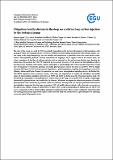Por favor, use este identificador para citar o enlazar a este item:
http://hdl.handle.net/10261/172074COMPARTIR / EXPORTAR:
 SHARE
BASE SHARE
BASE
|
|
| Visualizar otros formatos: MARC | Dublin Core | RDF | ORE | MODS | METS | DIDL | DATACITE | |

| Título: | Ubiquitous healthy diatoms in the deep sea confirms deep carbon injection by the biological pump |
Autor: | Agustí, Susana CSIC ORCID; González-Gordillo, J. Ignacio CSIC ORCID; Vaqué, Dolors CSIC ORCID ; Estrada, Marta CSIC ORCID ; Cerezo, María Isabel CSIC; Salazar, Guillem CSIC ORCID; Gasol, Josep M. CSIC ORCID ; Duarte, Carlos M. CSIC ORCID | Fecha de publicación: | 17-abr-2016 | Editor: | European Geosciences Union | Citación: | Geophysical Research Abstracts 18: EGU2016-2073 (2016) | Resumen: | The role of the ocean as a sink for CO2 is partially dependent on the downward transport of phytoplankton cells packaged within fast-sinking particles. However, whether such fast-sinking mechanisms deliver fresh organic carbon down to the deep bathypelagic sea and whether this mechanism is prevalent across the ocean awaits confirmation. Photosynthetic plankton, directly responsible for trapping CO2 in organic form in the surface layer, are a key constituent of the flux of sinking particles and are assumed to die and become detritus upon leaving the photic layer. Research in the 1960-70’s reported the occasional presence of well-preserved phytoplankton cells in the deep ocean, but these observations, which could signal at rapid sinking rates, were considered anecdotal. Using new developments we tested the presence of healthy phytoplankton cells in the deep sea (2000 to 4000 m depth) along the Malaspina 2010 Circumnavigation Expedition, a global expedition sampling the bathypelagic zone of the Atlantic, Indian and Pacific Oceans. In particular, we used a new microplankton sampling device, the Bottle-Net, 16S rDNA sequences, flow cytometric counts, vital stains and experiments to explore the abundance and health status of photosynthetic plankton cells between 2,000 and 4,000 m depth along the Circumnavigation track. We described the community of microplankton (> 20 μ m) found at the deep ocean (2000-4000 m depth), surprisingly dominated by phytoplankton, and within this, by diatoms. Moreover, we report the ubiquitous presence of healthy photosynthetic cells, dominated by diatoms, down to 4,000 m in the deep dark sea. Decay experiments with surface phytoplankton suggested that the large proportion (18%) of healthy photosynthetic cells observed, on average, in the dark ocean, requires transport times from few days to few weeks, corresponding to sinking rates of 124 to 732 m d-1, comparable to those of fast sinking aggregates and faecal pellets. These results confirm the expectation that fast-sinking mechanisms inject fresh organic carbon into the deep-sea and that this is a prevalent process operating across the global oligotrophic ocean | Descripción: | European Geosciences Union General Assembly 2016 (EGU2016), 17-22 April 2016, Vienna, Austria.-- 1 page | Versión del editor: | https://meetingorganizer.copernicus.org/EGU2016/orals/20366 | URI: | http://hdl.handle.net/10261/172074 | Identificadores: | issn: 1607-7962 |
| Aparece en las colecciones: | (ICM) Comunicaciones congresos (IMEDEA) Comunicaciones congresos |
Ficheros en este ítem:
| Fichero | Descripción | Tamaño | Formato | |
|---|---|---|---|---|
| Agusti_et_al_2016.pdf | 19,41 kB | Adobe PDF |  Visualizar/Abrir |
CORE Recommender
Page view(s)
175
checked on 12-may-2024
Download(s)
46
checked on 12-may-2024
Google ScholarTM
Check
Este item está licenciado bajo una Licencia Creative Commons

